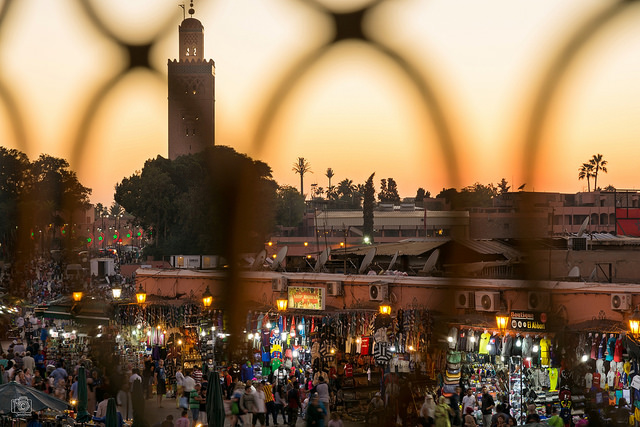Updated
The Magnificence of Marrakech — Ambassador Edward M. Gabriel (ret.)

Evening at Jemaa El-Fnaa Photo: Jennifer Stahn
Ambassador Edward M. Gabriel (ret.)
May 17, 2018
 Morocco is unlike any other country I’ve visited and, having had the fortune of being US Ambassador there for over three years, I learned much about the people and the country. It is unlike any other in the world.
Morocco is unlike any other country I’ve visited and, having had the fortune of being US Ambassador there for over three years, I learned much about the people and the country. It is unlike any other in the world.
Although the majority of Moroccans are Arab and Sunni Muslim, it would be incomplete to call Morocco an Arab country. And although it’s part of Africa, it would not be accurate to simply refer to it as an African country, with its indigenous Berber and Jewish roots. King Hassan II once compared Morocco to a giant tree, with its roots in Africa, its trunk in the Arab and Muslim world and its branches in Europe, denoting its multi-cultural and multi-ethnic aspect. It is so unique that it should be on every American’s list for must see destinations.
For me, Marrakech is the jewel of Morocco with its colorful souks (markets), old storytellers, artists and performers in the Jemaa el Fna town square, a western night life rare in the Middle East, and a very special people – the Marrakchi – who are fun loving and mystical. The town is draped by the snowcapped High Atlas Mountains, towering to nearly 14,000 feet, and a climate like Palm Springs California.
Two important considerations in Marrakech are what to do and where to stay. I’d like to offer my top three favorites.
No one should go to Morocco without stopping by La Mamounia Hotel, which just completed a major multi-million-dollar renovation, and is rated one of the best in the world. It was one of Winston Churchill’s favorite hotels in his beloved getaway, Marrakech, where he often painted in a relaxing setting within its spectacular gardens. He even invited President Franklin Roosevelt to Marrakech for a few days following the famous Casablanca Conference of January 1943 during which both the US and Great Britain produced the Casablanca Declaration calling for an “unconditional surrender” of the Axis powers. If you don’t stay at La Mamounia, I highly recommend that you at least stop by for lunch and a walk in the garden
In my opinion, no hotel on the planet is more unusual and elegant than Le Royal Mansour. With the careful oversight of King Mohammed VI, it is made to feel like you are living in a luxurious riad (traditional house) in the old medina (inner quarter) of Marrakech. From its beautiful chandeliers, sculpted plaster, fountains and lighting designs by the famous artist Yahya, to its unforgettable restaurants decorated with luxurious Moroccan antiques, the place is a once in a lifetime memory. Each riad has an open courtyard and living space on the first floor; bedrooms on the second level; a private pool and outdoor living on the roof; and your own attendant to wait on you at the push of a button. This is the place for Hollywood stars, foreign leaders and a once in a lifetime experience.
For me, staying in the medina itself is the best way to discover Marrakech, with its bustling alleyways, smell of exotic spices and tastes, proximity to Yves Saint Laurent’s famous Majorelle Garden, the new YSL Museum, and the amazing night life. For that, there is no better lodging than La Maison Arabe, the first riad in Morocco turned into a boutique hotel. With about 30 rooms, all decorated in traditional furniture, artwork and antiques, it is a place you will call home after one visit. David Rockefeller, after his first visit there, remarked that he hoped his next visit would be even longer. The hotel’s restaurant is one of the finest in Marrakech and the staff will immediately become your extended family. Fabrizio Ruspoli, its owner, has even fashioned an English style pub, complete with piano player and bartenders that will keep you entertained the entire night. La Maison Arabe also has a farm a short distance away, in the lush Palm forests of Marrakech, where you can take cooking lessons, a walk in the woods or a swim in the pool.
Finally, no article would be complete without mentioning the three most important things to do while in Marrakech. The most important is a day in the souk, which excites all your senses: the pleasant smell of kebab on the grill and fresh produce and spices; the sounds of the barkers selling their goods and motorbikes weaving in and out of traffic; the passing donkeys politely bumping you as they carry their loads to various stalls; and the sights of the colorfully dressed people in their traditional garb.
The nightlife is particularly interesting, not because you can’t find the same thing in any city in America, but because it’s a moderate Muslim country that prides itself on its modernity, openness, tolerance, and happiness, expressed in an almost daring manner.
The biggest memory however may be a day in the High Atlas Mountains with my friend Mohammed Id Hammou in his village of Id Hammou, where you will be treated to a marvelous lunch with his siblings and a walk through the village. The beauty of the mountains makes you feel like you’re in the Himalayas. Kundun, an epic biographical film about the Dalai Lama’s life in Tibet was filmed there. I promise you it will be the memory of all memories.
So don’t miss Marrakech. It will be one of the most memorable trips of your life.